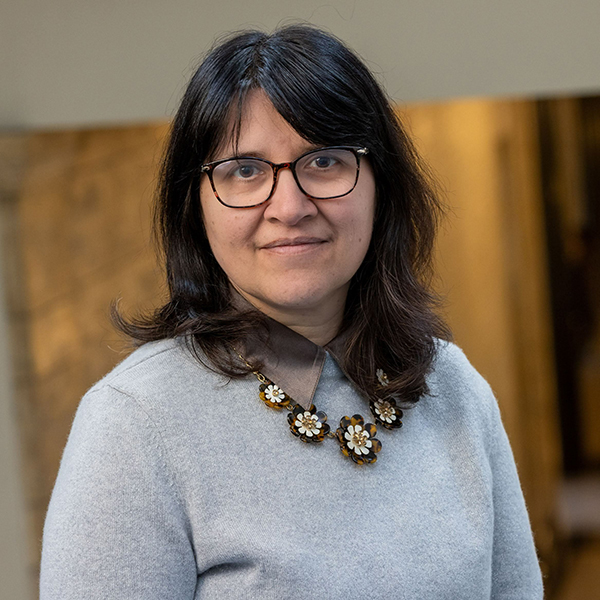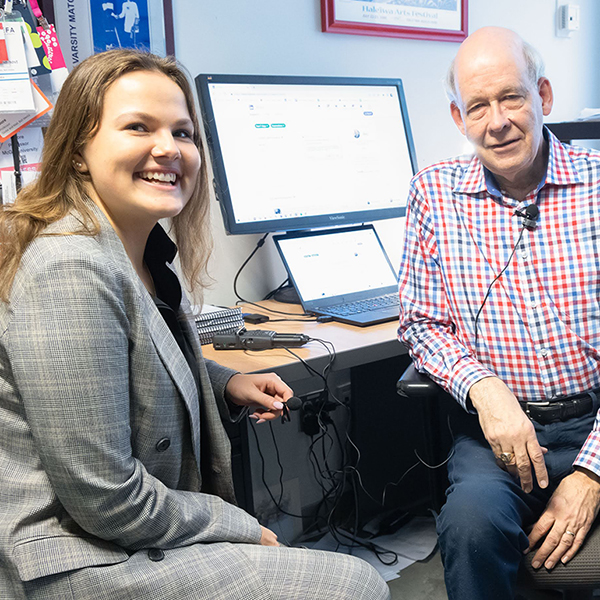Professor Peter Sabor of McGill’s Department of English is on a treasure hunt – and you might be able to help.
It starts with a visit to an online library made here at McGill by Sabor and his team of graduate students, a virtual space unique in Canada and probably the world.
Visit the website – and step into a different century. Admire the watercolour renderings of the library’s laden bookcases, and let your eyes stray over the hundreds of book spines. Click on a book to “open” it and see a selection of its pages, some with notes in looping script handwritten more than two centuries ago.
The books and the 6,000 digital images they contain painstakingly recreate the library where Jane Austen perfected some of the best (and best-loved) novels in the English language. The virtual library is the centerpiece of Reading with Austen, a collaboration between McGill’s Burney Centre and Chawton House, the estate-turned-museum in Kent that houses most of the remaining volumes of the long-dispersed original library.
Godmersham Park was the inherited residence of Jane Austen’s brother, Edward Austen Knight. Jane Austen began a series of lengthy visits to the estate in 1798. Its library offered the striving writer a critical space to work and read voraciously, and it fuelled the formation of her novels, says Sabor, McGill’s Canada Research Chair in Eighteenth Century Studies and director of the Burney Centre.
Today, Austen is one of the best-known writers in the English language, but at the time she was unpublished, reworking the drafts that would become Sense and Sensibility, Pride and Prejudice, and Northanger Abbey in obscurity – and as an unmarried woman, her situation was precarious.
“We know that because she had very limited means, she had very few books of her own,” explains Sabor. “There are only about 20 books that we know Jane Austen owned personally. But this library had over 1,200.”
Austen scholars know she loved the library, Sabor explains, thanks to her correspondence: “She wrote these wonderful letters where she talks about how pleased she is that everyone is leaving the house – she loves it when they go and play billiards, for instance. Anything to leave her in peace in the library.”
Indeed, the website greets visitors with a joyful line from one such letter, to Austen’s sister, Cassandra: “I am now alone in the Library, Mistress of all I survey.”
Her love of the space is hardly surprising. “It’s a dream, this library,” says Sabor. “The range is terrific.”
His team’s study of the library’s contents has revealed interesting findings about the books Austen had access to. The collection included standard canonical works, as well as many classical works in translation (an asset to a young woman like Austen, who would not have learned Greek or Latin), along with some surprising content.
“It has about 50 books known to be by women authors,” Sabor elaborates. “And that may sound like a small proportion, but in fact it’s rather high. A gentleman’s library at the time would typically have very few women authors. The Knights seem to have been somewhat progressive in this respect.”
This meant that Austen would have been able to read works by living women writers as they were published, including authors like Fanny Burney, Charlotte Turner Smith, and Ann Radcliffe (whose style she memorably spoofed in Northanger Abbey).
“She was keenly interested in what her female contemporaries were writing,” says Sabor, “But she couldn’t buy these books herself. They were simply too expensive for her.”
Jane Austen died in 1817, at the age of 41. Time marched on, and the estate changed hands. Much of the library’s collection was sold off during the 20th century, the books’ new ownership and location unknown. One key remained: a handwritten manuscript catalogue of the Godmersham books, completed in 1818. The catalogue had one intriguing peculiarity; it lists not just titles and authors, but also the physical location of each book on the library’s shelves.
“We knew right away that this was a really rare resource,” says Catherine Nygren, a PhD candidate in the Department of English and the Burney Centre’s research coordinator. “Because the catalogue listed the location of the books, it gave us an opportunity to really envision the library as a physical space.”
What’s next for Reading with Austen? Nygren explains that work continues: the site, and the data set that supports it, are meant to be a living resource that can be used by teachers and researchers. Plans are underway to expand on resources for educators teaching about Austen, her time, or print culture.
The digital project’s virtual shelves also link outward to a transatlantic treasure hunt, in collaboration with the Godmersham Lost Sheep Society (GLOSS), a group of scholars and bibliophiles devoted to restoring the original collection.
The goal is to locate and acquire these “lost sheep” and return them to the collection at Chawton House, or to academic libraries where they can be preserved and made available to researchers and the public.
Along with academic partners in the United Kingdom and GLOSS, Sabor’s team at the Burney Centre is also preserving these rediscovered books in the virtual space.
“The key identifier is usually the Montagu Knight bookplate, of which there are three,” Sabor explains, noting the decorative label usually added to a book to signify ownership. “If you find any of those bookplates, you’re in business.”
The pandemic caused disruption for the project – Sabor had to cut short a research trip to England mid-March – but things are still moving.
Excitingly, amid the turmoil of March 2020, one newly discovered Godmersham book was acquired at auction for the McGill Library: John Long’s Voyages and Travels of an Indian Interpreter and Trader, published in 1791. The new book joins the three-volume Godmersham copy of The American Gazetteer (1762), gifted to McGill by Lawrence Lande, a private donor, in 1965, part of the Lande Collection of Canadiana. The new addition includes valuable context for European-Indigenous interaction in the 18th century.
Apart from antiquarian book auctions, the books have turned up in surprising places, from a previously unnoticed volume in the British Library, to private bookshelves.
“People have indeed found stuff on their shelves thanks to our project,” laughs Sabor, explaining how a chance conversation at a conference in Niagara Falls yielded a new discovery. After hearing Sabor describe his Reading with Austen work, a fellow attendee told him she had a Montagu Knight bookplate in her 1761 illustrated edition of Aesop’s fables. Images of her volume are now part of the digital collection.
The bookplates, with their ornate coats of arms and heraldic symbols, can be viewed on the Reading with Austen site. So check the digital library, then check your own; you never know what treasures you might find.


